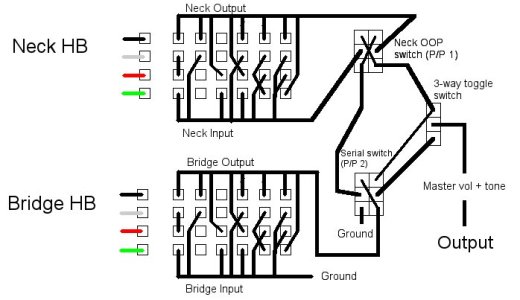omg81
New member
Re: Gaps in the Wiring Diagrams?
Here it is:

The beauty in it is that you get 156 settings without drilling any holes into your Gibson, hence I call it the "Gibsanity". You need two 4P6T rotary switches, two P/P pots, and keep the 3-way toggle switch. The OOP P/P puts the neck pup out of phase with the bridge, the serial P/P puts bridge and neck in series and overrides the 3-way toggle.
Each HB gets its own rotary switch:
1. standard HB (series, in phase)
2. Coil split north (inside coil)
3. Coil split south (outside coil)
4. Both coils parallel
5. Both coils in series, out of phase with itself
6. Both coils in parallel, out of phase with itself
With two pups, you get 6X6=36 settings. Neck out of phase switch doubles that to 72, series switch doubles that again to 144. Add to that 6 settings for each single pup to a total of 156.
If you spot a mistake in my wiring, please tell me.
edit: no idea why that isn't in SD's official wiring diagrams...
I thought of a ridiculous HH wiring that allows all settings I can theoretically think of, to a total of (edit) 156. Haven't yet made a diagram, maybe I'll do one soon.
Why? I think I might turn my Epiphone into a test guitar to find out my favourite settings for possible future wirings.
Here it is:

The beauty in it is that you get 156 settings without drilling any holes into your Gibson, hence I call it the "Gibsanity". You need two 4P6T rotary switches, two P/P pots, and keep the 3-way toggle switch. The OOP P/P puts the neck pup out of phase with the bridge, the serial P/P puts bridge and neck in series and overrides the 3-way toggle.
Each HB gets its own rotary switch:
1. standard HB (series, in phase)
2. Coil split north (inside coil)
3. Coil split south (outside coil)
4. Both coils parallel
5. Both coils in series, out of phase with itself
6. Both coils in parallel, out of phase with itself
With two pups, you get 6X6=36 settings. Neck out of phase switch doubles that to 72, series switch doubles that again to 144. Add to that 6 settings for each single pup to a total of 156.
If you spot a mistake in my wiring, please tell me.
edit: no idea why that isn't in SD's official wiring diagrams...
Last edited:


